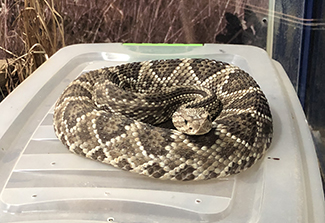Optimizing access to antivenom in the Amazon
September / October 2022 | Volume 21 Number 5
 Courtesy of Charles Gerardo While most people bitten by poisonous snakes in the Amazon, like this cotton mouth viper, receive antivenom, it is often administered past the recommended six-hour window.
Courtesy of Charles Gerardo While most people bitten by poisonous snakes in the Amazon, like this cotton mouth viper, receive antivenom, it is often administered past the recommended six-hour window.
By Susan Scutti
The current generation of antivenoms may be imperfect, still they are an “efficacious and extremely safe” therapy for snakebite, said Dr. Charles Gerardo, a professor and emergency medicine specialist at Duke University. “Yet antivenoms are not getting into people—if no one ever sees antivenom in a timely fashion due to travel times, lack of infrastructure, lack of knowledge, then it does no good.” Gerardo has been conducting a study to improve antivenom access and distribution in Brazil, the results of which he hopes can be applied in other regions in the world.
Over the past five years, Brazil recorded roughly 140,000 cases of snakebite. Of these, about 70,000 resulted in death or illness. One aim of Gerardo’s project is to create a distribution model for antivenom, which is state produced at Instituto Butantan, using Brazil’s existing network of community health centers (CHCs) embedded within its nationalized health care system. Joao Ricardo Vissoci, co-investigator and an assistant professor at Duke, explained, “The data showed a majority of snakebite events in the Amazon do receive antivenom, but a large proportion are delayed—meaning outside the six-hour window.” (There’s a greater likelihood of death or lasting effects when patients receive antivenom more than six hours after a bite.)
A crucial parameter in creating a distribution model, then, is the ability for most of the at-risk population to be able to travel to an antivenom site within six hours of a bite. Addressing this, the team, which includes Brazilian colleagues at the Tropical Medicine Center in Manaus, Amazonas, mixed “implementation science with data science,” said Vissoci.
Progressive methods to find solutions
Gerardo explained: “We took satellite imagery to find man-made structures and attributed populations to those areas. Then we had to determine travel times.” Given most people in the Amazon travel by river, the team created datasets of the entire river basin at two different times of the year—during the wet season and the "wetter" season. “Once we modeled where the people are and how long it would take to get them to care,” said Gerardo, "then we could begin to generate location allocation plans—which CHCs do we (stock with antivenom) based on this data?”
Next, the team piloted a training process for teaching community health workers how to administer antivenom, including identifying types of snakebite, dealing with allergic reactions, and when to transfer a patient to a higher level of care. The team also established clinical practice guidelines and minimum requirements for individual CHCs to qualify for administering antivenom. Finally, the team conducted various cost-effectiveness analyses, which showed that providing treatment at CHCs reduces hospital use and gets antivenom into patients faster. “So we're building this nice package to bring to the policymakers, and we’ll say, ‘Okay here's this cool digital tool and it's going to tell you where to send your antivenom and how many vials you need to send,’” said Vissoci.
 Courtesy of Charles Gerardo
A common pit viper in the Amazon
Courtesy of Charles Gerardo
A common pit viper in the Amazon
Meeting the 2030 WHO goal
“If we continue on this path, we are on track to meet the 2030 WHO goal of reducing death and disability by snakebite in Brazil,” said Vissoci. Brazilian by birth, he said it is essential to build bridges across institutions and countries to contribute to global health. “We should be leveraging data better in the low-income world, because it takes a lot of work for people in these countries to generate that data. The computing capacity Duke has, including cloud computing data science techniques, means I can deploy artificial intelligence in the Amazon to understand how to distribute healthcare resources.”
Gerardo said the project’s results may not be easily generalizable to countries that lack Brazil’s impressive health care infrastructure. “We will have to come up with additional solutions for environments that don't have those same resources. That said, they may have other resources, so lessons learned will still be valuable, even if modification is required.” He also noted that, even if improved antivenoms are produced in the future, distribution will still be of great importance.
While the global pandemic impacted the project, the team “navigated COVID pretty well,” said Gerardo, noting “a lot of this work involved advanced geospatial (analysis) and artificial intelligence and used existing data. We overcame challenges by being innovative.” The team remains on track and now most of the work is “in the manuscript or presentation phase, which is where we should be right now.”Gerardo, who routinely applies lessons learned from other fields to his own work, believes that some of his own team’s methods and ideas may be applicable to other research areas. Vissoci concluded, “Snakebite is a good example of a disease that is completely treatable so we should do a better job of giving people access to treatment.”
More Information
Updated October 6, 2022
To view Adobe PDF files,
download current, free accessible plug-ins from Adobe's website.
Related World Regions / Countries
Related Global Health Research Topics